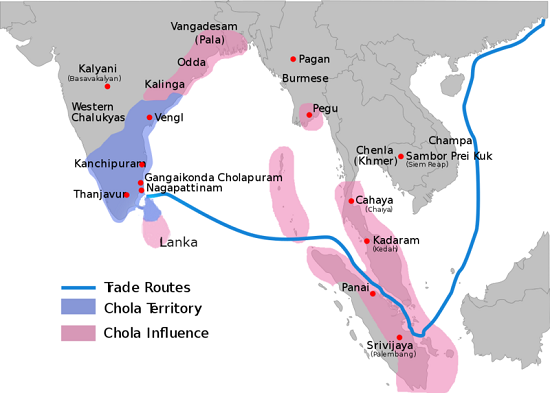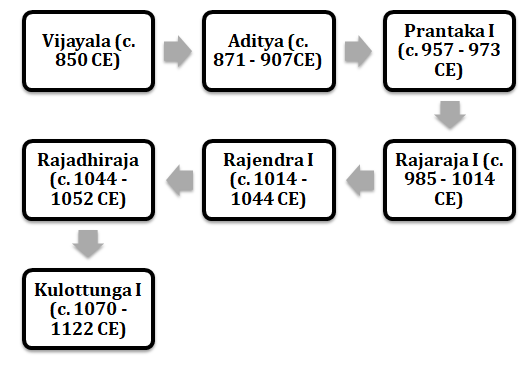

The Cholas for over 350 years conquered parts of south India and overthrew powers like Pallavas. They were also responsible for building numerous important temples throughout South India, influencing the cultural background of these areas. The kingdom saw its rise during the reign of Vijayala and fell during the reign of Kulottunga. The fall of the great empire happened mainly due to internal; conflicts.

The Cholas were known to be one of the most influential Dynasties of early medieval South India. During this time they extended their kingdom up to the river Tungabhadra Their chief language was Tamil, and it reached its pinnacle in terms of art and literature, during this era.
The Chola Empire had conquered the Pallavas and thus had permanently printed their name in the history of South India. Their domain had extended to parts of Sri Lanka and the Malay peninsula as well.

The names and other details of the Chola rulers are hereby given below according to the timeline
Vijayala − He was the founder of the Chola Empire and came into power at approximate c. 850 CE. He worked as a feudatory to the Pallavas at the beginning, until he conquered Tanjore and established a Durga temple there.
Aditya − He ruled between c. 871 – 907 CE and defeated Aparajita the last ruler of the Pallava Kingdom. He also took over Tondaimandalam which is now known to be the northernmost part of Tamil Nadu.
Prantaka I − This ruler reigned between c. 957 – 973 CE and was responsible for defeating the Pandyas and also the king of Ceylon, in the great Battle of Vellur. He also lost the battle of Takkolam against the Rashtrakuta King Krishna III. He built the golden roof at the Nataraja Temple of Chidambaram.
Rajaraja I − Rajaraja I, popularly known as Arumolivarman was perhaps the most influential ruler among the Cholas. His victory against the powerful western Chalukyas of Kalyani was an important achievement. This is the way he was able to stretch his empire to the Tungabhadra river. He also was responsible for the building of the Rajarajeshwara temple in Tanjor. The changes he brought to the economic system were ahead of their time. He was called the Ulagalanda Perumal which stands for the king who measured the earth. He established a revenue system where the land was to be measured first before assessing the revenue.
Rajendra I − He was the son of Rajaraja I and he continued his father’s legacy perfectly by expanding the kingdom through conquests. His reign witnessed the entire Sri Lanka under the control of the Cholas. He pushed his control in the countries of Chera and Pandya. He was responsible for the marking of the river Tungabhadra as the borderline between the Cholas and the Chalukyas by defeating the West Chalukyan king, Jayasimha II. Due to his thirst for knowledge and learning, he was called the Pandita Cholan.
Rajadhiraja − he reigned between c. 1044 – 1052 CE and became popular as he stayed on the frontline during the battles. He was responsible for the destruction of the Chalukyan city of Kalyani. He got killed in the battle of Koppam, which he fought against the western Chalukyan king Someshwar. He was given the title of Yanai-mel-thunjina Devar, due to this glorious death. This title meant, the king who had his death, on an elephant back.
Kulottunga I − It is during the reign of Kulottunga I between c. 1070 – 1122 CE that the Chola empire saw its decline.
The caste system was highly in order in the Chola dynasty. Brahmans and Kshatriyas were always on top of the hierarchy. The Valangai and the Idangai were the two major groups of castes
The economy of the dynasty mainly centred around agriculture and farming. The advanced irrigation system helped in this venture. The advancing industries of metals and textiles also played a huge part in the economy. Kanchipuram became a hub of weaving industries.
The king was central according to the Chola administration. He was referred to as the Ko Perumal Adigal meaning the great one. The Rashtriyam or the empire was formed of eight mandalams (provinces) and to each province, a prince was appointed. These provinces were further divided into Nadus or districts. These Nadus included a lot of autonomous villages. The group of merchants were known as Nagaram, they handled specific trades according to the groups.
The Chola village administration contained two assemblies, namely the Ur or the general assembly, and the Sabah or Mahasabha. The Ur was specified as the assembly of the residents of the brahmadeya villages. The sabhas, on the other hand, were formed by the brahmans.
Literature saw a great uprising during the reign of the Cholas. Alvars who were the Vishnu devotees and Nayannars who were the Shiva devotees were responsible for writing numerous religious books in Tamil. They were later released in 11 volumes called the Tirumurais. During this period the famous writer Kamban translated the Ramayana.
The Cholas were the most powerful empires of the early medieval Sothern India. They conquered most of South India under great rulers. The most important Chola ruler was Rajaraja I. During his reign which extended from c. 985 – 1014 CE, the Cholas reached their pinnacle in terms of power and cultural significance. He won the battle of Kandalur Salai, defeated the Pandya ruler, Amarabhujanga and extended his kingdom up to Tungabhadra. The administrative system of the Cholas was greatly impressive, and their knowledge of the economy was remarkable and ahead of their time.
Q. Which Chola ruler was responsible for the invasion of North India?
It was under the reign of Rajendra I that the Cholas invaded parts of north India for the first time. He established the city of Gangaikondacholapuram to mark the success of the north Indian invasion.
Q. Who invaded Sri Lanka for the first time and what were his other military exploits?
Raajraja I the most influential Chola ruler invaded Sri Lanka for the first time, resulting in the fleeing of the Sri Lankan king Mahinda V. His other military exploits include the naval expedition through which he conquered the Maldives
Q. Who were the valangai and the idangai?
The Chola caste system was mainly divided into two groups, Valangai and the Indangai. Valangai referred to the agricultural groups and the Idangai referred to the trading class.